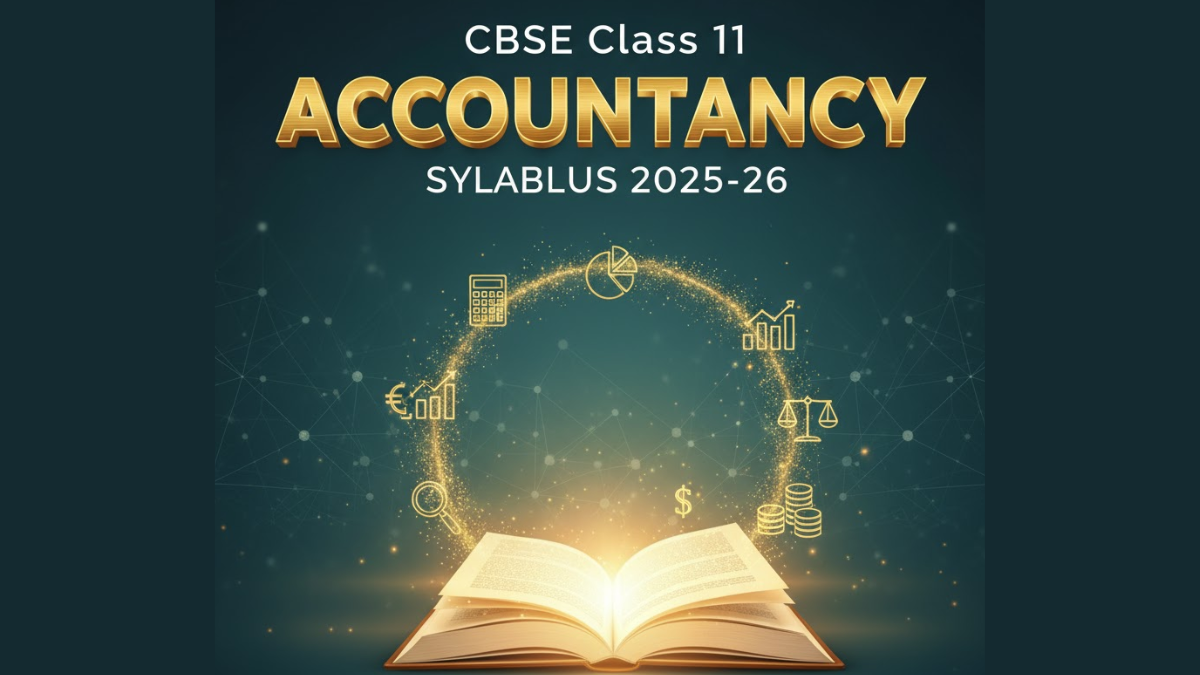CBSE Class 11 Accountancy Syllabus 2025-26: The CBSE Class 11 Accounts Syllabus PDF offers a comprehensive course framework as well as a topic-by-topic syllabus for the coming academic year. The NCERT Accountancy Class 11 Syllabus contains the parts, units, chapters, and names of the topics covered in each subject. Students can also examine the marks assigned to each unit in the syllabus. The complete curriculum is divided into 3 parts:
- Part A: Financial Accounting-1 – 56 Marks
- Part B: Financial Accounting-II – 24 Marks
- Part C: Project Work – 20 Marks
CBSE Class 11 Accountancy Syllabus 2025-26
Before beginning Accountancy exam preparation, students must first familiarise themselves with the entire CBSE Class 11 Accountancy Syllabus 2025-26. Students must review all the important chapters and develop a solid study schedule to complete the NCERT syllabus timely. All students can obtain the current syllabus for class 11 CBSE 2025-26 in PDF format from the CBSE’s official website, cbseacademic.nic.in, as well as the links provided on this page at last.
CBSE Class 11th Accountancy Syllabus 2026 Overview
This CBSE Class 11th Accountancy Syllabus 2026 will serve as the foundation for students in Class 12 and beyond. Students must actively learn the principles of Class 11 accounts syllabus and strive to master each lesson.
| Overview | Details | |
| Subject: | Accountancy | |
| Board Name: | Central Board of Secondary Examination | |
| Class: | 11 | |
| Subject Code: | 55 | |
| Total Marks: | 100 Marks | |
| Theory Marks: | 80 Marks | |
| Practical Marks | 20 Marks | |
| Exam Duration: | 3 Hours | |
| Course Structure of CBSE Class 11th Accountancy Syllabus 2026 | Marks | |
| Part A: Financial Accounting-1 | ||
| Unit-1: Theoretical Framework | 12 | |
| Unit-2: Accounting Process | 44 | |
| Part B: Financial Accounting-II | ||
| Unit-3: Financial Statements of Sole Proprietorship | 24 | |
| Part C: Project Work | 20 | |
Accountancy Class 11 Exam 2026: Question Typology
The following 3 are the types of questions asked in the CBSE Class 11th Accountancy paper:
| Typology of Questions | Marks | Percentage |
| Remembering and Understanding: Exhibit memory of previously learned material by recalling facts, terms, basic concepts, and answers. Demonstrate understanding of facts and ideas by organizing, comparing, translating, interpreting, giving descriptions, and stating main ideas |
44 | 55% |
| Applying: Solve problems to new situations by applying acquired knowledge, facts, techniques and rules in a different way. |
19 | 23.75% |
| Analyzing, Evaluating and Creating: Examine and break information into parts by identifying motives or causes. Make inferences and find evidence to support generalizations. Present and defend opinions by making judgments about information, validity of ideas, or quality of work based on a set of criteria. Compile information together in a different way by combining elements in a new pattern or proposing alternative solutions. |
17 | 21.25% |
| Total | 80 | 100% |
NCERT Class 11 Accountancy Syllabus 2026 Detailed
The detailed NCERT Class 11 Accountancy syllabus 2026 describes the chapters and units of study that students will be covering during the session. Read the complete syllabus below –
PART A: FINANCIAL ACCOUNTING – I
Unit-1: Theoretical Framework
Introduction to Accounting
Accounting- concept, meaning, as a source of information, objectives, advantages and limitations, types of accounting information; users of accounting information and their needs. Qualitative Characteristics of Accounting Information. Role of Accounting in Business.
· Basic Accounting Terms- Entity, Business Transaction, Capital, Drawings. Liabilities (Non Current and Current). Assets (Non Current, Current); Expenditure (Capital and Revenue), Expense, Revenue, Income, Profit, Gain, Loss, Purchase, Sales, Goods, Stock, Debtor, Creditor, Voucher, Discount (Trade discount and Cash Discount)
Theory Base of Accounting
· Fundamental accounting assumptions: GAAP: Concept
· Basic Accounting Concept : Business Entity, Money Measurement, Going Concern, Accounting Period, Cost Concept, Dual Aspect, Revenue Recognition, Matching, Full Disclosure, Consistency, Conservatism,
– Materiality and Objectivity
– System of Accounting. Basis of Accounting: cash basis and accrual basis
– Accounting Standards: Applicability of Accounting Standards (AS) and Indian Accounting Standards (IndAS)
– Goods and Services Tax (GST): Characteristics and Advantages.”
Unit-2: Accounting Process
Recording of Business Transactions
· Voucher and Transactions: Source documents and Vouchers, Preparation of Vouchers, Accounting Equation Approach: Meaning and Analysis, Rules of Debit and Credit.
· Recording of Transactions: Books of Original Entry- Journal
· Special Purpose books:
· Cash Book: Simple, cash book with bank column and petty cashbook
Purchases book
Sales book
Purchases return book
Sales return book
Journal proper
Note: Including trade discount, freight and cartage expenses for simple GST calculation.
Ledger: Format, Posting from journal and subsidiary books, Balancing of accounts
Bank Reconciliation Statement:
Need and preparation, Bank Reconciliation Statement
Depreciation, Provisions and Reserves
Depreciation: Meaning, Features, Need, Causes, factors
Other similar terms: Depletion and Amortisation
Methods of Depreciation:
i. Straight Line Method (SLM)
ii. Written Down Value Method (WDV)
Note: Excluding change of method
Difference between SLM and WDV; Advantages of SLM and WDV
Method of recoding depreciation
i.Charging to asset account
ii.Creating provision for depreciation/accumulated depreciation account
Treatment of disposal of asset
Provisions, Reserves, Difference Between Provisions and Reserves.
Types of Reserves:
i.Revenue reserve
ii.Capital reserve
iii.General reserve
iv.Specific reserve
v.Secret Reserve
Difference between capital and revenue reserve
Trial balance and Rectification of Errors
Trial balance: objectives, meaning and preparation
( Scope: Trial balance with balance method only)
Errors: classification-errors of omission, commission, principles, and compensating; their effect on Trial Balance.
Detection and rectification of errors;
(i)Errors which do not affect trial balance
(ii)Errors which affect trial balance
preparation of suspense account.”
Part B: Financial Accounting – II
Unit 3: Financial Statements of Sole Proprietorship
Units/Topics
“Financial Statements
Meaning, objectives and importance; Revenue and Capital Receipts; Revenue and Capital Expenditure; Deferred Revenue expenditure. Opening journal entry. Trading and Profit and Loss Account: Gross Profit, Operating profit and Net profit. Preparation. Balance Sheet: need, grouping and marshalling of assets and liabilities. Preparation. Adjustments in preparation of financial statements with respect to closing stock, outstanding expenses, prepaid expenses, accrued income, income received in advance, depreciation, bad debts, provision for doubtful debts, provision for discount on debtors, Abnormal loss, Goods taken for personal use/staff welfare, interest on capital and managers commission. Preparation of Trading and Profit and Loss account and Balance Sheet of a sole proprietorship with adjustments.
Incomplete Records
Features, reasons and limitations.
Ascertainment of Profit/Loss by Statement of Affairs method. (excluding conversion method)”
Part C: Project Work (Any One)
“1. Collection of source documents, preparation of vouchers, recording of transactions with the help of vouchers.
2. Preparation of Bank Reconciliation Statement with the given cash book and the pass book with twenty to twenty-five transactions.
3. Comprehensive project of any sole proprietorship business. This may state with journal entries and their ledgering, preparation of Trial balance. Trading and Profit and Loss Account and Balance Sheet. Expenses, incomes and profit (loss), assets and liabilities are to be depicted using pie chart / bar diagram. This may include simple GST related transactions.
CBSE Accountancy Class 11 Syllabus 2025-26 PDF Download
Students can download the PDFs. The Class 11 and Class 12 curricula have been merged into subject-specific PDFs to make it easier to navigate the curriculum.
| Subject | Download Link of NCERT Class 11 Accountancy Syllabus |
| Accountancy | Click Here |











 AILET 2026 AIR 1: Check Full Toppers Lis...
AILET 2026 AIR 1: Check Full Toppers Lis...
 AILET Result 2026 OUT, How to Download S...
AILET Result 2026 OUT, How to Download S...
 CUET PG Crash Course 2026: Subject-Wise ...
CUET PG Crash Course 2026: Subject-Wise ...














